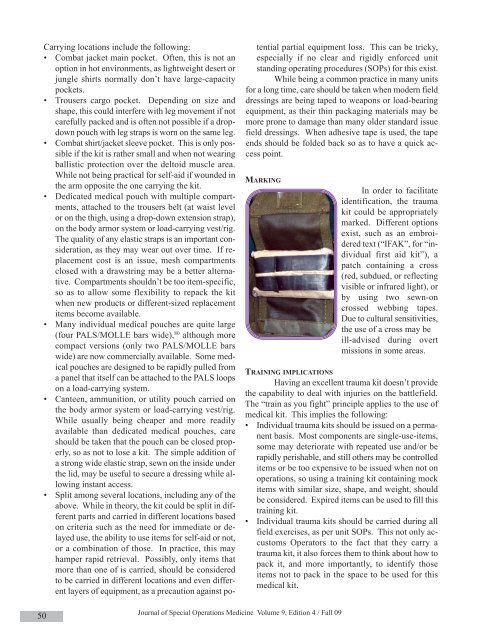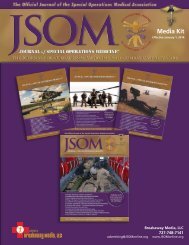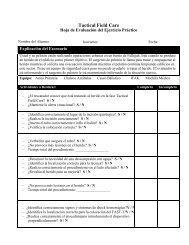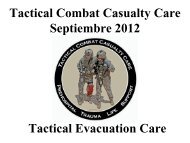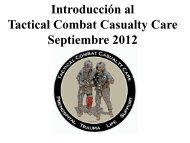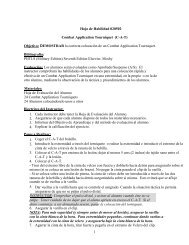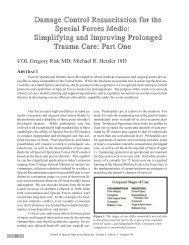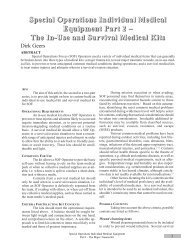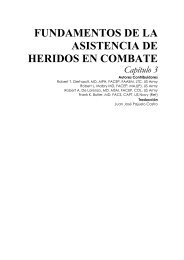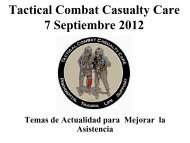Part One - The Major Trauma Kit. 09(4). - Journal of Special ...
Part One - The Major Trauma Kit. 09(4). - Journal of Special ...
Part One - The Major Trauma Kit. 09(4). - Journal of Special ...
Create successful ePaper yourself
Turn your PDF publications into a flip-book with our unique Google optimized e-Paper software.
Carrying locations include the following:<br />
• Combat jacket main pocket. Often, this is not an<br />
option in hot environments, as lightweight desert or<br />
jungle shirts normally don’t have large-capacity<br />
pockets.<br />
• Trousers cargo pocket. Depending on size and<br />
shape, this could interfere with leg movement if not<br />
carefully packed and is <strong>of</strong>ten not possible if a dropdown<br />
pouch with leg straps is worn on the same leg.<br />
• Combat shirt/jacket sleeve pocket. This is only possible<br />
if the kit is rather small and when not wearing<br />
ballistic protection over the deltoid muscle area.<br />
While not being practical for self-aid if wounded in<br />
the arm opposite the one carrying the kit.<br />
• Dedicated medical pouch with multiple compartments,<br />
attached to the trousers belt (at waist level<br />
or on the thigh, using a drop-down extension strap),<br />
on the body armor system or load-carrying vest/rig.<br />
<strong>The</strong> quality <strong>of</strong> any elastic straps is an important consideration,<br />
as they may wear out over time. If replacement<br />
cost is an issue, mesh compartments<br />
closed with a drawstring may be a better alternative.<br />
Compartments shouldn’t be too item-specific,<br />
so as to allow some flexibility to repack the kit<br />
when new products or different-sized replacement<br />
items become available.<br />
• Many individual medical pouches are quite large<br />
(four PALS/MOLLE bars wide), 80 although more<br />
compact versions (only two PALS/MOLLE bars<br />
wide) are now commercially available. Some medical<br />
pouches are designed to be rapidly pulled from<br />
a panel that itself can be attached to the PALS loops<br />
on a load-carrying system.<br />
• Canteen, ammunition, or utility pouch carried on<br />
the body armor system or load-carrying vest/rig.<br />
While usually being cheaper and more readily<br />
available than dedicated medical pouches, care<br />
should be taken that the pouch can be closed properly,<br />
so as not to lose a kit. <strong>The</strong> simple addition <strong>of</strong><br />
a strong wide elastic strap, sewn on the inside under<br />
the lid, may be useful to secure a dressing while allowing<br />
instant access.<br />
• Split among several locations, including any <strong>of</strong> the<br />
above. While in theory, the kit could be split in different<br />
parts and carried in different locations based<br />
on criteria such as the need for immediate or delayed<br />
use, the ability to use items for self-aid or not,<br />
or a combination <strong>of</strong> those. In practice, this may<br />
hamper rapid retrieval. Possibly, only items that<br />
more than one <strong>of</strong> is carried, should be considered<br />
to be carried in different locations and even different<br />
layers <strong>of</strong> equipment, as a precaution against potential<br />
partial equipment loss. This can be tricky,<br />
especially if no clear and rigidly enforced unit<br />
standing operating procedures (SOPs) for this exist.<br />
While being a common practice in many units<br />
for a long time, care should be taken when modern field<br />
dressings are being taped to weapons or load-bearing<br />
equipment, as their thin packaging materials may be<br />
more prone to damage than many older standard issue<br />
field dressings. When adhesive tape is used, the tape<br />
ends should be folded back so as to have a quick access<br />
point.<br />
MARKING<br />
In order to facilitate<br />
identification, the trauma<br />
kit could be appropriately<br />
marked. Different options<br />
exist, such as an embroidered<br />
text (“IFAK”, for “individual<br />
first aid kit”), a<br />
patch containing a cross<br />
(red, subdued, or reflecting<br />
visible or infrared light), or<br />
by using two sewn-on<br />
crossed webbing tapes.<br />
Due to cultural sensitivities,<br />
the use <strong>of</strong> a cross may be<br />
ill-advised during overt<br />
missions in some areas.<br />
TRAINING IMPLICATIONS<br />
Having an excellent trauma kit doesn’t provide<br />
the capability to deal with injuries on the battlefield.<br />
<strong>The</strong> “train as you fight” principle applies to the use <strong>of</strong><br />
medical kit. This implies the following:<br />
• Individual trauma kits should be issued on a permanent<br />
basis. Most components are single-use-items,<br />
some may deteriorate with repeated use and/or be<br />
rapidly perishable, and still others may be controlled<br />
items or be too expensive to be issued when not on<br />
operations, so using a training kit containing mock<br />
items with similar size, shape, and weight, should<br />
be considered. Expired items can be used to fill this<br />
training kit.<br />
• Individual trauma kits should be carried during all<br />
field exercises, as per unit SOPs. This not only accustoms<br />
Operators to the fact that they carry a<br />
trauma kit, it also forces them to think about how to<br />
pack it, and more importantly, to identify those<br />
items not to pack in the space to be used for this<br />
medical kit.<br />
50<br />
<strong>Journal</strong> <strong>of</strong> <strong>Special</strong> Operations Medicine Volume 9, Edition 4 / Fall <strong>09</strong>


